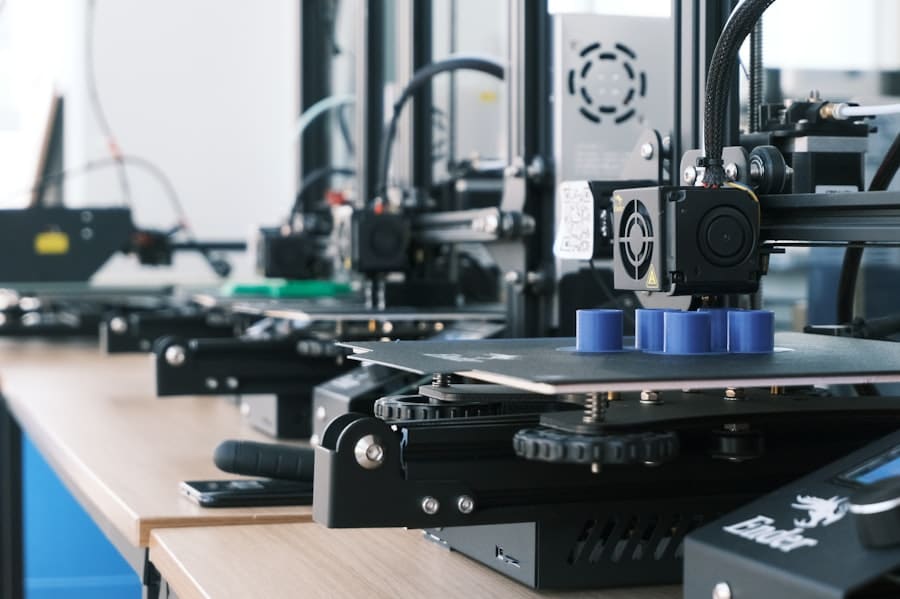Farming technology has undergone a remarkable transformation over the centuries, evolving from rudimentary tools to sophisticated machinery and systems that enhance productivity and efficiency. In ancient times, agriculture relied heavily on manual labor and simple implements such as wooden plows and hand-held sickles. The advent of the Industrial Revolution in the 18th and 19th centuries marked a significant turning point, introducing mechanized equipment like the seed drill and the mechanical reaper.
These innovations not only increased crop yields but also reduced the labor intensity of farming, allowing for larger areas to be cultivated. As the 20th century progressed, advancements in technology continued to reshape agriculture. The introduction of tractors revolutionized fieldwork, enabling farmers to plow, plant, and harvest with unprecedented speed and efficiency.
The development of synthetic fertilizers and pesticides further enhanced agricultural productivity by providing essential nutrients and protecting crops from pests and diseases. However, these advancements also brought about environmental concerns, leading to a growing awareness of sustainable practices. In recent decades, the integration of digital technology has ushered in a new era of farming, characterized by precision agriculture, where data analytics and GPS technology are employed to optimize resource use and improve crop management.
Key Takeaways
- Farming technology has evolved significantly over the years, from manual labor to advanced automation and robotics.
- Automation in farming offers advantages such as increased efficiency, reduced labor costs, and improved precision in crop production and livestock management.
- In crop production, automation technologies such as precision planting, irrigation systems, and harvesting equipment have revolutionized the way crops are grown and harvested.
- Livestock management has also benefited from automation, with technologies like automated feeding systems, robotic milking machines, and health monitoring systems improving productivity and animal welfare.
- Robotics and drones are increasingly being used in farming for tasks such as planting, spraying, monitoring crop health, and gathering data, leading to more efficient and sustainable farming practices.
Advantages of Automation in Farming
The automation of farming processes offers numerous advantages that significantly enhance agricultural productivity and sustainability. One of the most notable benefits is the reduction in labor costs. As the global population continues to grow, the demand for food increases, placing immense pressure on farmers to produce more with fewer resources.
Automation allows for the efficient use of machinery and technology to perform tasks that would otherwise require extensive human labor. This not only alleviates labor shortages but also enables farmers to allocate their workforce to more strategic roles within their operations. Moreover, automation enhances precision in farming practices.
Automated systems can monitor soil conditions, weather patterns, and crop health in real-time, allowing farmers to make informed decisions based on accurate data. For instance, automated irrigation systems can adjust water delivery based on soil moisture levels, ensuring that crops receive the optimal amount of water without wastage. This precision not only conserves resources but also leads to improved crop yields and quality.
Additionally, automation can facilitate better pest management through targeted application of pesticides, reducing chemical usage and minimizing environmental impact.
Automation in Crop Production

In crop production, automation has transformed traditional farming methods into highly efficient systems that maximize output while minimizing resource use. One prominent example is the use of autonomous tractors equipped with GPS technology. These tractors can navigate fields with precision, performing tasks such as planting, tilling, and harvesting with minimal human intervention.
By utilizing advanced algorithms and sensors, these machines can optimize their routes and adjust their operations based on real-time data, resulting in increased efficiency and reduced fuel consumption. Another significant advancement in automated crop production is the implementation of robotic harvesters. These machines are designed to identify ripe fruits and vegetables using computer vision technology, allowing them to selectively harvest crops without damaging plants or produce.
For instance, companies like Harvest CROO Robotics have developed strawberry-picking robots that can work tirelessly throughout the day, significantly increasing harvest efficiency while addressing labor shortages in the agricultural sector. Such innovations not only enhance productivity but also ensure that crops are harvested at their peak ripeness, improving overall quality.
Automation in Livestock Management
Automation is also making significant strides in livestock management, where technology is being employed to improve animal welfare and operational efficiency. One of the key areas where automation has been beneficial is in feeding systems. Automated feeders can dispense precise amounts of feed at scheduled intervals, ensuring that livestock receive adequate nutrition without overfeeding or waste.
This not only optimizes feed costs but also contributes to healthier animals and improved growth rates. In addition to feeding systems, automated monitoring technologies are being utilized to track the health and behavior of livestock. Wearable devices equipped with sensors can monitor vital signs such as heart rate and temperature, alerting farmers to potential health issues before they escalate into serious problems.
For example, companies like Allflex offer ear tags that provide real-time data on animal activity levels and reproductive status, enabling farmers to make informed decisions regarding breeding and health management. This proactive approach not only enhances animal welfare but also improves overall herd productivity.
Robotics and Drones in Farming
The integration of robotics and drones into farming practices represents a significant leap forward in agricultural technology. Drones are increasingly being used for aerial surveillance of crops, providing farmers with valuable insights into field conditions from above. Equipped with high-resolution cameras and multispectral sensors, drones can capture detailed images that reveal variations in crop health, moisture levels, and nutrient deficiencies.
Robotic systems are also making their mark in various aspects of farming beyond harvesting. For instance, robotic weeders utilize advanced algorithms to distinguish between crops and weeds, allowing them to remove unwanted plants without harming the desired yield.
Companies like Blue River Technology have developed such systems that employ machine learning to improve accuracy over time. By reducing reliance on chemical herbicides, these robotic solutions contribute to more sustainable farming practices while maintaining crop health.
Data-Driven Decision Making in Next-Generation Farming

The rise of data-driven decision-making is revolutionizing how farmers approach their operations. With the advent of big data analytics and cloud computing, farmers can now collect vast amounts of information from various sources, including soil sensors, weather stations, and market trends. This data can be analyzed to identify patterns and correlations that inform critical decisions regarding planting schedules, resource allocation, and pest management strategies.
For example, precision agriculture platforms like Climate FieldView allow farmers to visualize data from their fields in real-time, enabling them to make informed decisions based on current conditions rather than relying solely on historical practices. By leveraging data analytics, farmers can optimize inputs such as fertilizers and water while minimizing waste and environmental impact. This shift towards data-driven farming not only enhances productivity but also promotes sustainability by encouraging responsible resource management.
Challenges and Limitations of Automation in Farming
Despite the numerous advantages associated with automation in farming, several challenges and limitations must be addressed for widespread adoption. One significant concern is the high initial investment required for advanced technologies such as autonomous machinery and data analytics systems. Many small-scale farmers may find it difficult to afford these technologies, leading to a potential divide between large agribusinesses that can invest in automation and smaller farms that may struggle to keep pace.
Additionally, there are concerns regarding the reliability and maintenance of automated systems.
Farmers must also contend with the learning curve associated with adopting new technologies; training staff to operate complex machinery or interpret data analytics can be time-consuming and resource-intensive.
The Future of Next-Generation Farming Systems
Looking ahead, the future of next-generation farming systems appears promising as technology continues to evolve at a rapid pace. Innovations such as artificial intelligence (AI) are expected to play a pivotal role in shaping agricultural practices by enabling more sophisticated decision-making processes. AI algorithms can analyze vast datasets to predict crop yields, optimize planting schedules, and even forecast market trends based on consumer behavior.
Moreover, advancements in biotechnology may lead to the development of crops that are more resilient to climate change and pests while requiring fewer inputs such as water and fertilizers. As sustainability becomes increasingly important in agriculture, practices such as vertical farming and aquaponics are gaining traction as viable alternatives to traditional farming methods. These systems utilize controlled environments to maximize space efficiency while minimizing resource use.
In conclusion, the evolution of farming technology has paved the way for a new era characterized by automation and data-driven decision-making. While challenges remain, the potential benefits of next-generation farming systems are vast, promising a future where agriculture is more efficient, sustainable, and capable of meeting the demands of a growing global population.
In the rapidly evolving field of agriculture, automation is playing a pivotal role in enhancing efficiency and productivity. The article “Exploring Automation in Next-Generation Farming Systems” delves into the innovative technologies transforming modern farming practices. For those interested in the intersection of technology and design, a related article worth exploring is Best Software for UX. This piece provides insights into user experience software that can be crucial for developing intuitive interfaces in agricultural technology, ensuring that these advanced systems are accessible and user-friendly for farmers.
FAQs
What is automation in next-generation farming systems?
Automation in next-generation farming systems refers to the use of technology and machinery to perform tasks traditionally carried out by humans. This can include automated planting, irrigation, harvesting, and monitoring of crops and livestock.
What are the benefits of automation in farming?
Automation in farming can lead to increased efficiency, reduced labor costs, improved crop yields, and more precise use of resources such as water and fertilizer. It can also help farmers to monitor and manage their operations more effectively.
What are some examples of automation in next-generation farming systems?
Examples of automation in next-generation farming systems include autonomous tractors and machinery, robotic harvesters, drones for crop monitoring, automated irrigation systems, and sensor-based technologies for monitoring soil conditions and plant health.
How does automation impact sustainability in farming?
Automation in farming can contribute to sustainability by reducing the use of resources such as water and fertilizer, minimizing waste, and optimizing the use of land. It can also help farmers to adopt more environmentally friendly practices and reduce their carbon footprint.
What are the challenges of implementing automation in farming?
Challenges of implementing automation in farming include the high initial cost of technology and machinery, the need for specialized skills and training, and potential disruptions to traditional farming practices. Additionally, there may be concerns about job displacement and the impact on rural communities.

